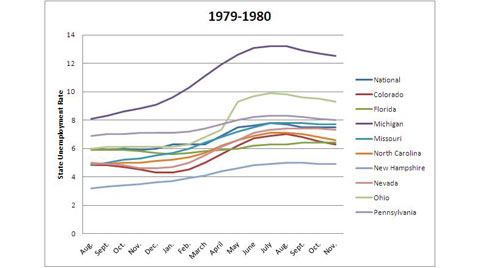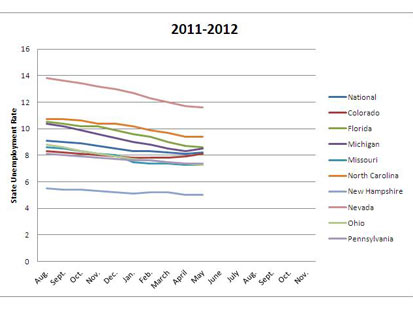Charts: Swing-State Economies in 2012 Election
President Obama has seen unemployment rates drop in swing states, leading some to wonder whether this bodes well for his re-election chances.
Recent history offers little guidance. In 1980 and 1992, the last two election years that focused heavily on the economy and unemployment, swing-state unemployment was behaving differently four months before Election Day, and sitting presidents Jimmy Carter and George H.W. Bush lost all or most of the swing states now critical for Obama.
One thing is clear: If state unemployment rates can swing elections, Obama has it far better than his two economically challenged incumbent predecessors.
Since last August, unemployment has dropped in all nine of these swing states: Colorado, Florida, Michigan, Missouri, New Hampshire, Nevada, North Carolina, Ohio, and Pennsylvania. In five perennial swing states more suited to historical comparison-Florida, Michigan, Missouri, Ohio, and Pennsylvania-Obama has seen unemployment drop an average of 1.46 percentage points since August.
In 1992 and 1980, by contrast, unemployment had risen in these states.
In June 1992, George W. Bush had seen unemployment rise .66 of a percentage point on average in the five swing states listed above, since the previous August. It rose in all except Missouri (where it fell .2 points), and Bush won only Florida. Carter had it much worse. Unemployment rose an average of 2.2 percentage points in those five states, increasing in all, and Carter lost all five to Ronald Reagan.

Carter's state economies
NOTE: The chart above shows 1979 and 1980 unemployment rates that are NOT seasonally adjusted, departing from the typical way unemployment numbers are reported. These are the only data available from BLS. Both the 1979/1980 and 1991/1992 charts show data that has been revised a handful of times by BLS; they represent BLS's best guess at what unemployment really was in those states in those months, not what BLS reported at the time.

Bush's state economies

Obama's state economies
Not only has Obama averaged a better trend in these nine states, he's experienced a lot more months of good news in each of them.
Since last August, unemployment has risen in swing states during four months. In the five states for comparison, it has risen only once-in Michigan in May-while it's fallen 39 times.
In June 1992, George W. Bush had seen the unemployment rate rise 26 times in the same five states, while rates fell only three times-twice in Missouri in the fall, and once in Michigan in April. In 1980, Carter had seen unemployment rise in those states 33 times and fall three times-for three consecutive months in Michigan.
Both Carter and Bush, of course, lost their elections, but but the historical comparisons are far from perfect. Ross Perot's presence on the ballot in 1992, for instance, makes it difficult to correlate Bush's performance to other variables, and the competitiveness of each "swing state" varied over the years.
Neither of these elections, however, offer a true test of Obama supporters' hypothesis that the trajectory of unemployment, not the rate on Election Day, determines a presidential winner.
Get more pure politics at ABC News.com/Politics and a lighter take on the news at OTUSNews.com
At this moment in 1992, swing-state economies had declined over the previous 10 months, and they were just beginning to turn around. Between July and Election Day, most of them did, but Bush lost most of them regardless. In July 1980, some swing-state economies had worsened since the previous August, while some had improved-but they were all getting worse over the summer; none would get better until the fall, and Carter lost all of them.
Last month brought bad news, with the national rate climbing from 8.1 percent to 8.2 percent. Unemployment rose in both Colorado and Michigan-a troubling sign for Obama, politically.